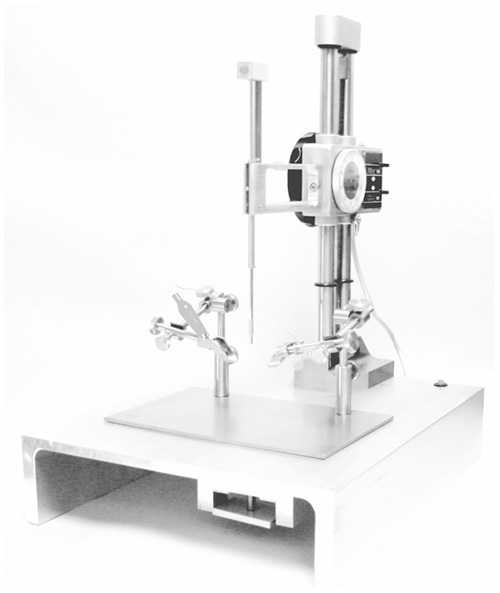
NYU脊椎冲击损伤仪
产品名称: NYU脊椎冲击损伤仪
英文名称: MASCIS Impactor
产品编号: Impactor II
产品价格: 0
产品产地: NYU
品牌商标: NYU
更新时间: null
使用范围: null
上海迪奥生物科技有限公司
- 联系人 :
- 地址 : 上海市斜土路1175号景泰大厦1508
- 邮编 : 200032
- 所在区域 : 上海
- 电话 : 138****7942 点击查看
- 传真 : 点击查看
- 邮箱 : shdobio@163.com
一)仪器组成;
1)BASE
2)MAIN BODY
3)CLAMPING SYSTEM
4)IMPACTOR ROD
二)检测参数
1)高度调节范围:0mm-300mm
2)大鼠撞击头重量:10克 2.5mm直径
3)小鼠撞击头重量:5克 1.2mm直径
三)保修
保修1年
由NYU(W.M. Keck Center for Collaborative Neuroscience, Rutgers the State University of New Jersey) 出品, 在全世界很受歡迎。其產品目前有分兩款,一是model I,可以接電腦,二是model II,可以不接電腦,這兩款大/小鼠均可以使用,且發表論文也非常多,在脊椎損傷研究中,有超過50%的論文都是用NYU impactor來發表的。
Overview
The MASCIS Impactor is a device designed to deliver graded reproducible spinal cord contusions in rats.
Developed over ten years ago, the Impactor is part of a well-defined rodent spinal cord injury model that is used in over 100 laboratories around the world. Most of the recommended procedures for the Impactor are based on experience with the model and work done by the Multicenter Animal Spinal Cord Injury Study (MASCIS). The Impactor is now in its third generation with many improvements over previous models.
Introduction
The MASCIS Impactor, formerly called the NYU Impactor, was developed in 1991 by Drs. John Gruner, Carl Mason, and Wise Young. It is now used in laboratories throughout the world in their spinal cord injury studies. The device precisely
measures the movement of a 10-gram rod dropped 12.5, 25.0, or 50.0 mm onto the T9-10 spinal cord exposed by laminectomy. In addition, the device measures movement of the spinal column at the impact site, displays the trajectory of the falling rod, and measures the impact velocity (ImpV), cord compression distance (Cd), cord compression time (Ct), and cord compression rate (Cr). These impact parameters correlate with each other and spinal cord lesion volumes (estimated from tissue Na and K concentrations) and locomotor recovery (BBB scores).
In addition, NYU Impactor allows the end user to measure below parameter:
Impact velocity (ImpV)
cord compression distance (Cd)
cord compression time (Ct)
cord compression rate (Cr)
Clamping systems are available for both rat and mice. A clamping system is necessary for NYU Impactor. When Using Clamping system, a CS-tie device is needed.
Size
The MASCIS Impactor is 17” high x 12” deep and 10” wide.
It weighs approximately 11 pounds.
The MASCIS Impactor is a device designed to deliver graded reproducible spinal cord contusions in rats. Developed over ten years ago, the Impactor is part of a well-defined rodent spinal cord injury model that is used in over 100 laboratories around the world. In addition, more than 50% of recent publications on spinal cord injury research used the MASCIS Impactor. Most of the recommended procedures for the Impactor are based on experience with the model and work done by the Multicenter Animal Spinal Cord Injury Study (MASCIS).
The Impactor is now in its third generation with many improvements over previous models. It is available in a model with data recording capability (description and picture links) which requires a Pentium computer. It is also available in a basic model (The Rutgers Impactor) which only does the impact, not the recording of data.
Clamping systems are available for both rat and mouse. A clamping system is necessary for the Rutgers basic model and serves as a functional enhancement for the MASCIS model. When using a clamping system with the MASCIS model, a CS-tie device also is needed.
Hyun JK, Lee YI, Son YJ, Park JS.
J Neurotrauma. 2009 Feb 9.
Dankook University College of Medicine, Rehabilitation Medicine, San 16-5 Anseo-dong, Cheonan, Korea, Republic of, 330-714, 82-41-550-6640, 82-41-551-7062; rhhyun@dankook.ac.kr.
The aims of this study were to evaluate the evolution of the neurogenic bladder after spinal cord contusion, and to correlate changes in bladder function with locomotor function and levels of neurotrophic factors. The MASCIS impactor was used to cause a mild contusion injury of the lower thoracic spinal cord of Sprague-Dawley rats. Rats were divided into four groups according to the length of time from injury to sacrifice, at 4, 14, 28, and 56 days after injury. Gait analysis was performed each week, and urodynamic study was performed just before sacrifice. Basso, Beattie, and Bresnahan (BBB) and coupling scores showed gradual recovery, as did the urinary voiding pattern and bladder volume; some parameters of micturition reached normal ranges. Brain-derived neurotrophic factor (BDNF) levels in the spinal cord, as detected by enzyme-linked immunosorbent assay, decreased with time, whereas neurotrophin-3 (NT-3) levels remained unchanged. The micturition pattern, bladder volume and locomotor function continued to recover during the time of observation; BDNF levels in the spinal cord and bladder were inversely correlated with BBB scores and the restoration of bladder volume. We conclude that urodynamic changes in the bladder correlate with locomotion recovery but not with the levels of BDNF or NT3 after modified mild contusion injury in rats.
